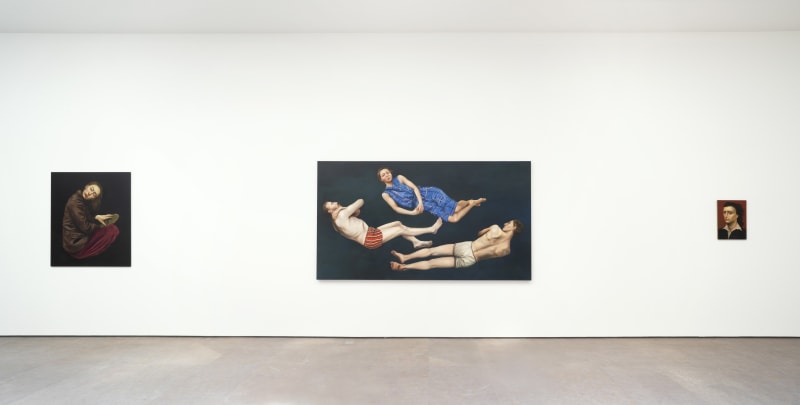Galerie Nathalie Obadia is pleased to present Belgian artist Sophie Kuijken's fifth exhibition, following her 2020 show in Brussels. Shielded from the limelight for nearly 20 years, then unveiled for the first time in 2011 at the Dhondt-Dhaenens Museum, under the encouragement of its director Joost Declerq, Sophie Kuijken's pictorial oeuvre is a highly singular addition to the art of portraiture.
Following in the footsteps of Flemish painting, Sophie Kuijken's work disrupts the genre's traditional codes from the inside, by adopting a deeply troubling contemporary approach. In an atypical space between two worlds, her portraits are imbued with a paradoxical presence, at once silent and scrutinizing, human and spectral, blurring the contours of humanity. The exhibition presents ten new paintings on wood panel and, for the first time, on canvas, which, more than ever, arouses in the viewer that sense of "disquieting weirdness" to which Sophie Kuijken possesses the secret.
Sophie Kuijken's works look, at first sight, like classical portraits on a dark ground, in the style of the Flemish Primitives. True to a long pictorial tradition that originated in the invention of oil paint, the artist works patiently by applying primers, layers and glacis onto the surface of the supports, whether wood or canvas. While acrylic allows for creating textural contrast, it is oil painting that achieves pictorial effects whose subtleties are intensified by the layers of glacis and varnish: shadows, the textures of fabrics and velvets, the nuances of skin and tone...
More broadly, the history of art permeates these paintings by way of certain details, postures, reminiscences that are more subconscious than intentional. The stretched silhouettes, for instance, and the raw flesh tones recall Mannerism; the elongated bodies in the work D.Z. evoke depositions from the cross; a female figure echoes the famous odalisques; a three-quarter, full- length portrait resembles a strange mirror image of Antonello da Messina's St. Sebastian; and the hand that captures the light in the portrait L.M.T. can be seen as a nod to the deeply expressive hands of Egon Schiele.
These underground influences enter into resonance with an active and systematic approach of collecting information on the internet. The artist sifts through hundreds of images and gleans, from this vast database, elements that, once assembled according to the feeling generated when they are confronted with each other, become her subjects. These artificially recreated beings thus mark an original counterpoint to the history of portraiture that was once intrinsically linked to a live model. This multiplicity of sources, this primordial dispersion of the subject establishes a diffuse mystery, that of a half-familiar, half-chimerical figure that flirts with the bizarre. The old-fashioned appearance of these portraits enhances the feeling of "disquieting weirdness," while the accessories or details that the artist bestows upon her characters makes the Freudian content even more coherent. Sophie Kuijken freely draws from the historical convention of giving the model a certain number of attributes that reveal their social status, their ethos. Punctuating each of these compositions with exquisite vagueness are a sunflower in the place of a foot, a lunar blackbird nesting in the topmost part of the painting, or an animal muzzle that converses with the semi-nudity of a person of indeterminate gender.
These incongruous associations show a tension between two opposites, like a painting whose strength lies in its contradictions, in avoidance. But, against all odds, they impose themselves in an impassive and natural manner, at the heart of each work, under the guise of mysterious affinities that determine their universe.
In fact, the ambiguity of these portraits also lies in the pure, imperturbable presence, within the pictorial field. The absence of background deprives the figures from any historic or contextual anchor, accentuating their spectral and timeless character: the bodies levitate in a nocturnal space that cradles them gently. Light suffuses their diaphanous skin in an effect of transparency that contrasts with the obscurity of the backgrounds and the opacity of hues, warm and dark, subtly nuanced.
The many layers of paint and glacis represent all the steps that are needed for these semi-real figures to emerge from the shadows. This strange community seems to have always been there, in a state of expectancy that imposes, in turn, a period of contemplation.
With great technical prowess, the artist works on the phenomena of memory and recognition, summoning at once the long history of art and the common, random and impersonal quality of digital resources. Under their classical style, Sophie Kuijken's paintings contain a deep marginality that is as comforting as it is disquieting, and in which each viewer is free to recognize himself.

